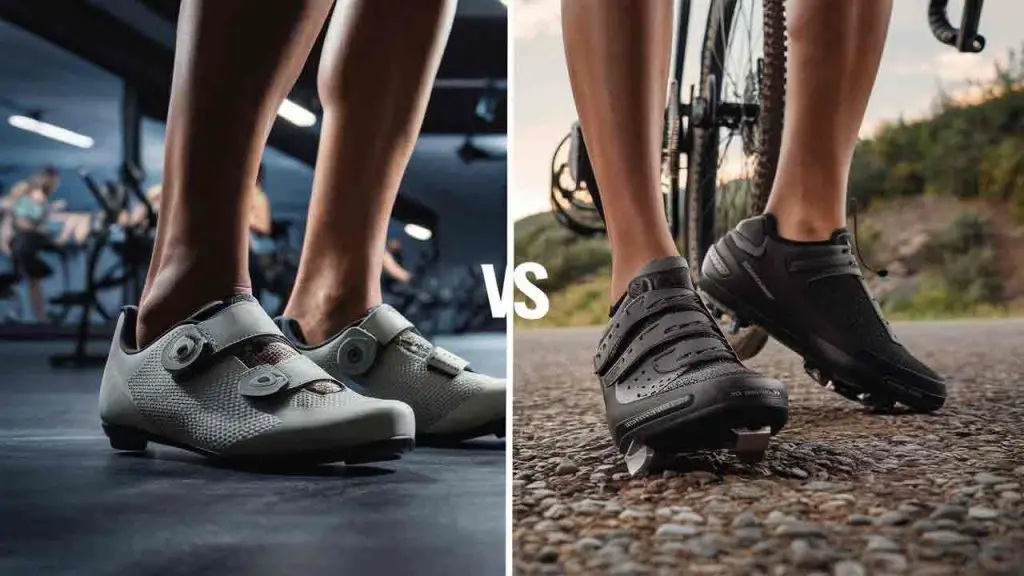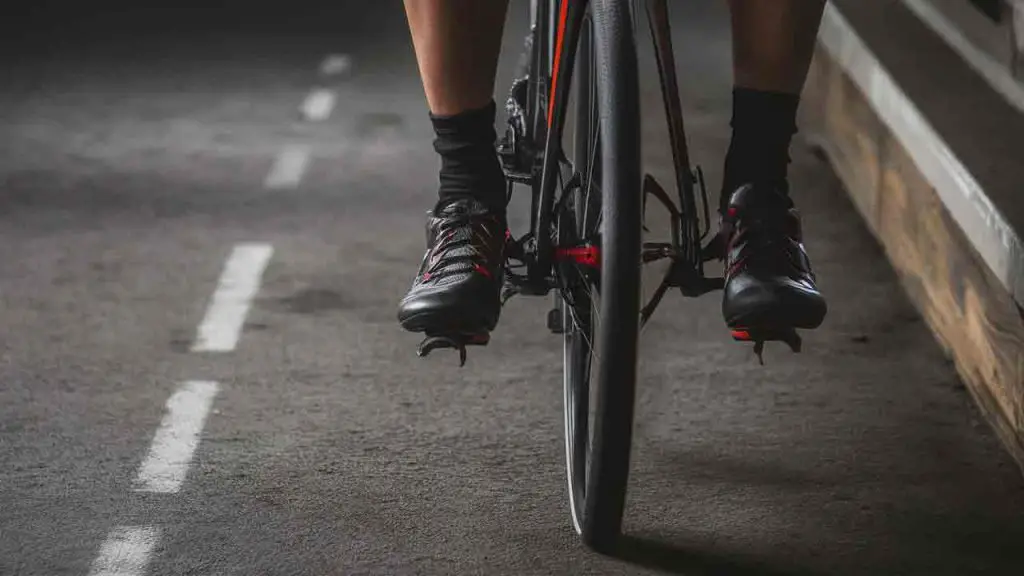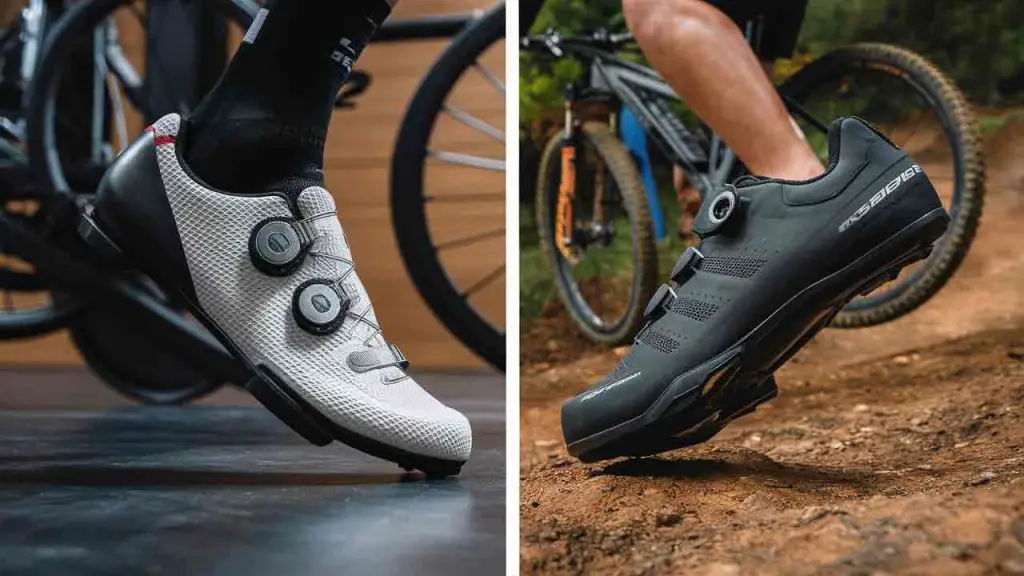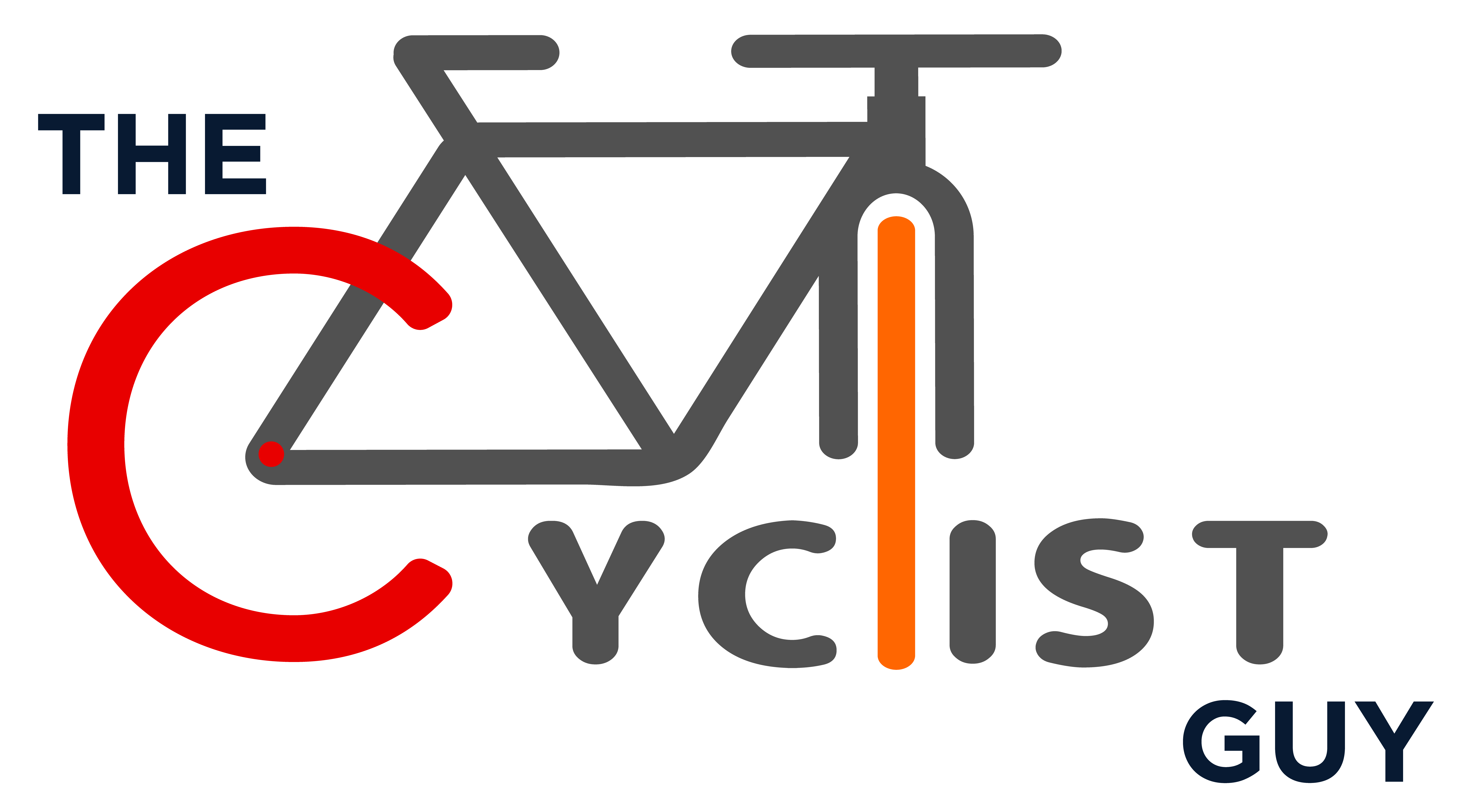Ce-up or buckle? Cleats or not? Indoor vs. Outdoor Cycling Shoes: Which Should You Choose?
These are two questions you might have thought about when selecting the perfect cycling footwear.
Right?
In fact, the difference between Indoor and outdoor cycling shoes can make a big difference in your performance and comfort.
Usually, Both serve different purposes based on your cycling needs. Indoor cycling shoes prioritize comfort and ventilation for stationary bikes and spin classes. They typically feature two-hole (SPD) cleat compatibility. Consequently, Power transfer and durability are key features of outdoor cycling shoes.
In this comparison guide, you’ll learn the key differences and considerations between indoor and outdoor cycling shoes. So, let’s dive in and find the perfect fit for your riding style!
Indoor Cycling Shoes: What Is It?

A spin class enthusiast’s secret weapon is their indoor cycling shoes. It’s more than just a regular pair of sneakers or bike shoes. They’re specially designed to make your workouts more enjoyable.
These shoes come with these nifty things called cleats on the bottom. You might find either three-hole (Delta) or two-hole (SPD) cleat systems.
A two-hole cleat is more versatile and allows you to walk with less noise, while three-hole cleats are more stable.
Also, ventilation is a big deal. You don’t want sweaty, overheated feet when you’re working out, right?
Ventilation holes are common in indoor cycling shoes to keep your feet cool. And remember insoles! You can customize your insoles for added comfort and support with some indoor cycling shoes.
Whether you’re pedaling in style or taking spin classes, these shoes will keep you comfortable.
Positive and Negative Aspects of Indoor Cycling Shoes
I am now going to provide a review of indoor cycling shoes, including their positives and negatives. Stay with me and keep your eyes on the below chart!
| Positives | Negatives |
| Efficient power transfer | Higher cost |
| Secure foot-pedal connection | Limited use for indoor cycling |
| Compatibility with various cleat systems | Less comfortable for walking |
| Comfortable fit and reduced blisters | Initial learning curve for cleat attachment |
| Ventilation to keep feet cool | |
| Customizable insoles | |
| Different fastening options | |
| Durability for long-term use |
Outdoor Cycling Shoes: What Is It?
For tough trails or hitting the open road, outdoor cycling shoes are your trusted companions. These specialized kicks are designed to enhance your cycling experience.
These shoes come equipped with cleats that attach to your pedals, creating a seamless connection between your feet and the bike. As a result, you can pedal efficiently and confidently while maximizing power transfer.

Outdoor cycling shoes are built tough to withstand the elements and the demands of your ride. They are firm yet flexible enough to allow comfortable walking when you dismount.
The breathable uppers keep your feet cool during long rides and prevent sweat buildup.
There are a variety of fastening options, including laces, ratchet straps, and boa dials so that you can customize your fit. No matter what you’re doing, these shoes will help you go the distance.
Positive and Negative Aspects of Outdoor Cycling Shoes
Let’s now examine the positives and negatives of outdoor cycling in more detail:
| Positives | Negatives |
| Efficient power transfer via clipless pedal compatibility | Can be expensive |
| Improved stability for better control | Not as comfortable as regular shoes for walking |
| Durable construction built to withstand outdoor conditions | A clipless pedal’s learning curve |
| Breathable uppers for long rides | Limited use primarily for cycling activities |
| Various fastening options | |
| Pedaling efficiency improves performance | |
| Ideal for specific outdoor cycling activities (road, mountain) | |
| Sturdy yet lightweight |
Indoor vs Outdoor Cycling Shoes: Quick Chart
Here is a quick chart of indoor/outdoor cycling shoes:
| Highlights | Indoor cycling Shoes | Outdoor cycling Shoes |
| Can vary in weight but are often designed for durability. | ||
| Weight | May be lighter due to less robust construction. | Can vary in weight but often designed for durability. |
| Use | Typically two-hole (SPD) or three-hole (Delta) cleat systems. | Compatible with various cleat systems depending on the type of riding (SPD, SPD-SL, Look, etc.) |
| Sole Flexibility | Soles are often more flexible for ease of walking. | Soles are stiffer for efficient power transfer and less flexible for walking. |
| Ventilation | Designed with ventilation for breathability during indoor workouts. | Ventilation varies but may be less prominent due to outdoor exposure. |
| Tread Pattern | Minimal or no tread pattern for smooth studio floors. | Tread patterns may provide grip on outdoor surfaces like roads or trails. |
| Durability | Built for indoor use, may have less rugged construction | Designed to withstand outdoor elements and rough terrain. |
| Pedal Comfort | Designed for comfort during extended indoor workouts, often with cushioned insoles. | May prioritize stiffness over cushioning for efficient power transfer. |
| Pedal Power | Focus on stability during indoor cycling; may have a slightly less stiff sole. | Designed for maximum power transfer, typically with a stiffer sole. |
| Versatility | Less versatile, primarily for indoor cycling | More versatile, can be used for different outdoor cycling disciplines. |
| Tread | Minimal or no tread for smooth indoor surfaces | Tread patterns may vary, providing grip on outdoor roads or trails. |
| Breathability | Designed with ventilation for cooling during indoor workouts. | May have ventilation but with an emphasis on protection from the elements |
| Fixation | May use Velcro straps or hook-and-loop closures for easy adjustments | Offer a variety of fixation methods, including laces, ratchet straps, and boa dials for a secure fit |
Key Differences Between Indoor and Outdoor Cycling Shoes

- Sole Stiffness and Design: Indoor shoes have softer soles and recessed cleats for walking ease, while outdoor shoes prioritize stiffness and durability.
- Cleat Compatibility: Indoor shoes typically use SPD cleats, whereas outdoor shoes may require specific cleats depending on the bike and terrain.
- Ventilation vs. Protection: Indoor shoes focus on ventilation, while outdoor shoes may offer additional protection from elements.
Choosing the Right Cycling Shoes for Your Needs
Your choice between indoor and outdoor cycling shoes depends on your cycling activities:
- Indoor Cyclists: If your primary focus is on indoor cycling, spin classes, or stationary biking, go for indoor cycling shoes. They provide the right balance of comfort, efficiency, and ease of use.
- Outdoor Cyclists: For road biking, mountain biking, or commuting, outdoor cycling shoes are essential. They offer superior performance, durability, and specialized features tailored to outdoor conditions.
What is the difference between indoor cycling shoes and outdoor?
A good pair of shoes can make or break your bike-riding experience, as I can attest from my experience in both realms. Grab a coffee and get ready to delve into the world of footwear.
Take a look at the differences between indoor and outdoor cycling shoes:
Weight:
As indoor cycling shoes are designed for use in a controlled environment, they tend to be lighter. They prioritize comfort during long indoor sessions, which often results in a lighter build.
Compared to indoor cycling shoes, outdoor cycling shoes are slightly heavier. Because they need to withstand the rigors of the open road or rugged trails.
Use:
indoor cycling shoes are designed specifically for indoor use, such as spin classes and stationary bikes in the gym.
On the contrary, Outdoor cycling shoes are designed to handle a variety of outdoor conditions. Such as road cycling, mountain biking, and touring.
Cleat Compatibility:
Typically, indoor cycling shoes have two-hole (SPD) or three-hole (Delta) cleat systems, which are appropriate for stationary bikes.
There are many types of outdoor cycling shoes, including SPD, SPD-SL, Look, and others.
Sole Flexibility:
Indoor Cycling Shoes often have more flexible soles to make walking in the gym or studio more comfortable.
Walking shoes are typically less flexible due to stiffer soles, which enhance pedal power transfer.
Ventilation:
When exercising indoors, ventilation is crucial to keeping your feet cool.
In outdoor cycling shoes, ventilation is often balanced with protection from wind and rain.
Tread Pattern:
Tread patterns on indoor shoes are minimal or non-existent since they’re designed for smooth, controlled surfaces.
But Outdoor cycling shoes may have varied tread patterns to provide grip and stability on outdoor roads, trails, and uneven terrain.
Durability:
Indoor cycling shoes focus on comfort and lightweight design and may not be as rugged as outdoor cycling shoes.
These cycling shoes are designed to withstand harsh conditions and outdoor elements.
Pedal Comfort:
Emphasize comfort for long indoor sessions, often incorporating cushioned insoles.
Prioritize power transfer with a focus on stability, which may mean a slightly less cushioned feel.
Comfort for Walking:
Designed with indoor comfort in mind, they are generally more comfortable for walking and off-bike activities.
While functional for walking, outdoor cycling may be less comfortable for extended periods of walking compared to regular shoes.
Pedal Power:
Focus on stability during indoor cycling sessions, often featuring a slightly less stiff sole to balance power transfer and comfort.
Prioritize efficient power transfer with a stiffer sole to maximize your pedal power on the open road or trails.
Thread:
Tread patterns on indoor shoes are minimal or non-existent. In gyms and studios, they’re meant for smooth, controlled surfaces.
On outdoor roads, trails, and uneven terrain, outdoor shoes feature more pronounced tread patterns.
This traction is essential for maintaining control in variable conditions.
Breathability:
Due to potentially crowded and warm indoor environments, indoor cycling shoes prioritize breathability to keep your feet cool.
While outdoor shoes include breathability, they often protect from wind and rain. This ensures comfort during varied weather conditions.
Fixation:
A Velcro strap or hook-and-loop closure is commonly used on indoor cycling shoes.
These allow for easy adjustments during indoor workouts, where quick changes may be necessary.
Laces, ratchet straps, and boa dials are popular fixation methods for outdoor cycling shoes. The systems ensure a secure and precise fit, which is essential for outdoor cycling.
Are Cycling Shoes Necessary?
Usually, it is optional to wear cycling shoes at all times. However, they provide benefits such as improved power transfer, stability, and comfort for serious cyclists. Consequently, they are extremely valuable.
Cycling shoes aren’t a strict requirement, but they are a valuable asset for anyone serious about cycling.
Here are a few reasons why:
- Stiff soles ensure more power is transferred to the pedals, increasing pedaling efficiency.
- On fast or technical rides, cycling shoes with cleats reduce the risk of slipping.
- The ergonomic designs and features prevent fatigue and discomfort during long rides.
- Different types of cycling shoes cater to different needs, such as road cyclists for speed or mountain bikers for off-road.
- Cycling shoes enhance pedal control, especially during sprints and climbs.
- With boa dials, ratchet straps, and Velcro, every rider gets a secure fit.
- Invest in high-quality cycling shoes if you plan to ride frequently.
While not mandatory, cycling shoes significantly improve the overall cycling experience, making them a valuable addition to any cyclist’s gear collection.
Can I Use Road Cycling Shoes For Indoor Cycling?
Yes, you can definitely use road cycling shoes for indoor cycling. In fact, many cyclists prefer it because of the stiff sole and the secure fit that road cycling shoes offer. With the rigid sole, you get better energy transfer from the legs to the pedals.
Additionally, road cycling shoes usually come with a three-hole cleat system that is compatible with most indoor cycling bikes.
It makes it easier to clip in and out of the pedals during intense indoor cycling sessions.
However, it’s important to note that road cycling shoes may only be ideal for some. It might be too firm and uncomfortable if you’re new to indoor cycling.
Use a softer sole and more flexible mountain biking shoes or specialized indoor cycling shoes in this case.
Ultimately, choosing road cycling shoes when riding indoors comes down to personal preference and comfort.
Try different options to find the right shoe that enhances your performance while keeping your feet comfortable.
Can I use Indoor Cycling Shoes Outdoors?
You can use indoor cycling shoes for outdoor riding, but they may be better. They lack the stiffness, durability, and grip needed for outdoor terrain and longer rides.
While it’s technically possible to use indoor cycling shoes for outdoor rides, it’s not the best choice for several reasons.
Indoor cycling shoes often have more flexible soles to make walking more comfortable during gym workouts. When cycling outdoors, this flexibility can reduce power transfer, especially on longer rides.
Even, outdoor conditions can be tougher on shoes than the controlled environment of a gym. When exposed to the elements and rough outdoor surfaces, indoor shoes might only last for a while.
Also, it is suitable for short, casual outdoor rides but not for road biking or mountain biking. If you plan to ride outdoors, invest in a pair of dedicated outdoor cycling shoes.
They are designed to handle varying terrain conditions.
Do You Need Special Shoes For Indoor Cycling?
There is no absolute requirement for special shoes designed for indoor cycling. However, they offer several advantages that can enhance your indoor cycling experience.
Generally, indoor cycling has taken the fitness world by storm, attracting enthusiasts of all levels with its high-intensity workouts and group atmospheres.
But Newcomers often wonder whether specialized cycling shoes are necessary.
It is possible to participate in indoor cycling classes while wearing regular athletic shoes. However, investing in a pair designed specifically for this activity can improve your experience.
In fact, it is important to wear specially designed indoor cycling shoes to reduce foot discomfort. It minimizes hot spots and blisters by preventing excessive movement inside the shoe.
Moreover, these shoes keep your feet cool while exercising with excellent arch support.
So, Make indoor cycling part of your fitness routine and invest in a pair – your feet will love you for it!
Frequently Asked Questions (FAQs) about Indoor vs. Outdoor Cycling Shoes
1. Can I use outdoor cycling shoes for indoor cycling?
Yes, you can use outdoor cycling shoes for indoor cycling, but it’s essential to ensure compatibility with your indoor bike’s pedals. Many indoor bikes use SPD cleats, so if your outdoor shoes are equipped with these, you should be fine. However, outdoor shoes might be less comfortable for indoor use due to their stiffer soles and less ventilation.
2. What are the main differences between indoor and outdoor cycling shoes?
Indoor cycling shoes typically have softer soles, recessed SPD cleats, and better ventilation, making them suitable for indoor environments. Outdoor cycling shoes, on the other hand, offer stiffer soles for enhanced power transfer, different cleat systems (like SPD-SL or Look), and additional features for weather protection.
3. Are indoor cycling shoes worth the investment?
If you frequently participate in spin classes or use a stationary bike at home, indoor cycling shoes are worth the investment. They provide better comfort, efficiency, and safety during your workouts compared to regular athletic shoes.
4. Can I walk comfortably in indoor cycling shoes?
Yes, indoor cycling shoes are designed with recessed SPD cleats, allowing for more comfortable walking compared to outdoor cycling shoes. However, they are still not ideal for long-distance walking as they are primarily designed for cycling.
5. What cleat system is best for indoor cycling shoes?
The most common cleat system for indoor cycling shoes is the SPD (Shimano Pedaling Dynamics) system. SPD cleats are small, durable, and recessed into the shoe’s sole, making them a popular choice for indoor cycling.
6. Do outdoor cycling shoes provide better performance than indoor shoes?
Outdoor cycling shoes are designed for specific cycling disciplines and generally offer better performance features, such as stiffer soles for power transfer, weather resistance, and more specialized cleat systems. However, they might not be as comfortable or practical for indoor cycling due to less ventilation and the need for compatible cleats.
7. How should I choose the right cycling shoes for both indoor and outdoor use?
To find a versatile cycling shoe for both indoor and outdoor use, look for shoes with a comfortable fit, adequate ventilation, and compatibility with different cleat systems like SPD. Some shoes offer dual compatibility with SPD and SPD-SL, making them suitable for both environme
Last Words
So there you have it, a comparison of indoor vs outdoor cycling shoes. Ultimately, the choice between the two will depend on your personal preference and needs.
For those who enjoy both indoor and outdoor cycling, it may be best to invest in shoes that can adapt to both environments.
However, if you primarily stick to one type of cycling, choosing a shoe specifically designed for that type of riding may provide a better experience.
Whichever you choose, the most important thing is to have a comfortable and safe ride. Have fun cycling!

Steven is a professional cyclist and his passion is cycling. He has been cycling for the last 6 years and he loves using bikes while outing as well. Based on his experiences with the different types of bikes; he is sharing his opinions about various bikes so that a beginner can start right away. Find him on Twitter @thecyclistguy Happy Biking.


Leave a Reply